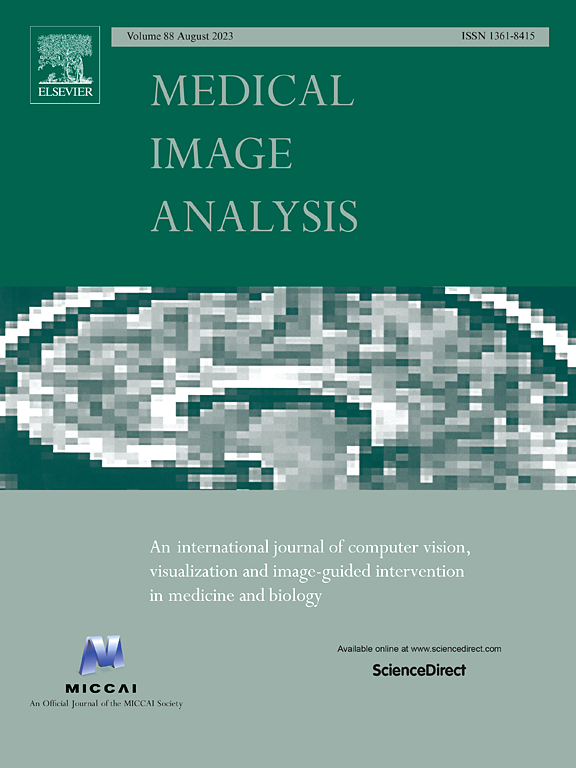Prompt-based polyp segmentation during endoscopy
IF 10.7
1区 医学
Q1 COMPUTER SCIENCE, ARTIFICIAL INTELLIGENCE
引用次数: 0
Abstract
Accurate judgment and identification of polyp size is crucial in endoscopic diagnosis. However, the indistinct boundaries of polyps lead to missegmentation and missed cancer diagnoses. In this paper, a prompt-based polyp segmentation method (PPSM) is proposed to assist in early-stage cancer diagnosis during endoscopy. It combines endoscopists’ experience and artificial intelligence technology. Firstly, a prompt-based polyp segmentation network (PPSN) is presented, which contains the prompt encoding module (PEM), the feature extraction encoding module (FEEM), and the mask decoding module (MDM). The PEM encodes prompts to guide the FEEM for feature extracting and the MDM for mask generating. So that PPSN can segment polyps efficiently. Secondly, endoscopists’ ocular attention data (gazes) are used as prompts, which can enhance PPSN’s accuracy for segmenting polyps and obtain prompt data effectively in real-world. To reinforce the PPSN’s stability, non-uniform dot matrix prompts are generated to compensate for frame loss during the eye-tracking. Moreover, a data augmentation method based on the segment anything model (SAM) is introduced to enrich the prompt dataset and improve the PPSN’s adaptability. Experiments demonstrate the PPSM’s accuracy and real-time capability. The results from cross-training and cross-testing on four datasets show the PPSM’s generalization. Based on the research results, a disposable electronic endoscope with the real-time auxiliary diagnosis function for early cancer and an image processor have been developed. Part of the code and the method for generating the prompts dataset are available at https://github.com/XinZhenRen/PPSM.

内镜检查中基于提示的息肉分割
准确判断和识别息肉的大小是内镜诊断的关键。然而,息肉的边界模糊导致了错误的分割和漏诊。本文提出了一种基于提示的息肉分割方法(PPSM),以辅助内镜下的早期肿瘤诊断。它结合了内窥镜医生的经验和人工智能技术。首先,提出了一种基于提示符的息肉分割网络(PPSN),该网络包含提示符编码模块(PEM)、特征提取编码模块(FEEM)和掩码解码模块(MDM)。PEM编码提示符指导FEEM提取特征,MDM生成掩码。因此,PPSN可以有效地分割息肉。其次,利用内窥镜医师的眼球注意数据(注视)作为提示,提高PPSN对息肉分割的准确性,在现实世界中有效获取提示数据。为了增强PPSN的稳定性,产生了非均匀点阵提示来补偿眼动追踪过程中的帧丢失。此外,引入了一种基于分段任意模型(SAM)的数据增强方法,丰富了提示数据集,提高了PPSN的自适应性。实验证明了该方法的准确性和实时性。在四个数据集上进行交叉训练和交叉测试的结果表明了PPSM的泛化性。在此基础上,研制了具有早期癌症实时辅助诊断功能的一次性电子内窥镜和图像处理器。生成提示数据集的部分代码和方法可从https://github.com/XinZhenRen/PPSM获得。
本文章由计算机程序翻译,如有差异,请以英文原文为准。
求助全文
约1分钟内获得全文
求助全文
来源期刊

Medical image analysis
工程技术-工程:生物医学
CiteScore
22.10
自引率
6.40%
发文量
309
审稿时长
6.6 months
期刊介绍:
Medical Image Analysis serves as a platform for sharing new research findings in the realm of medical and biological image analysis, with a focus on applications of computer vision, virtual reality, and robotics to biomedical imaging challenges. The journal prioritizes the publication of high-quality, original papers contributing to the fundamental science of processing, analyzing, and utilizing medical and biological images. It welcomes approaches utilizing biomedical image datasets across all spatial scales, from molecular/cellular imaging to tissue/organ imaging.
 求助内容:
求助内容: 应助结果提醒方式:
应助结果提醒方式:


